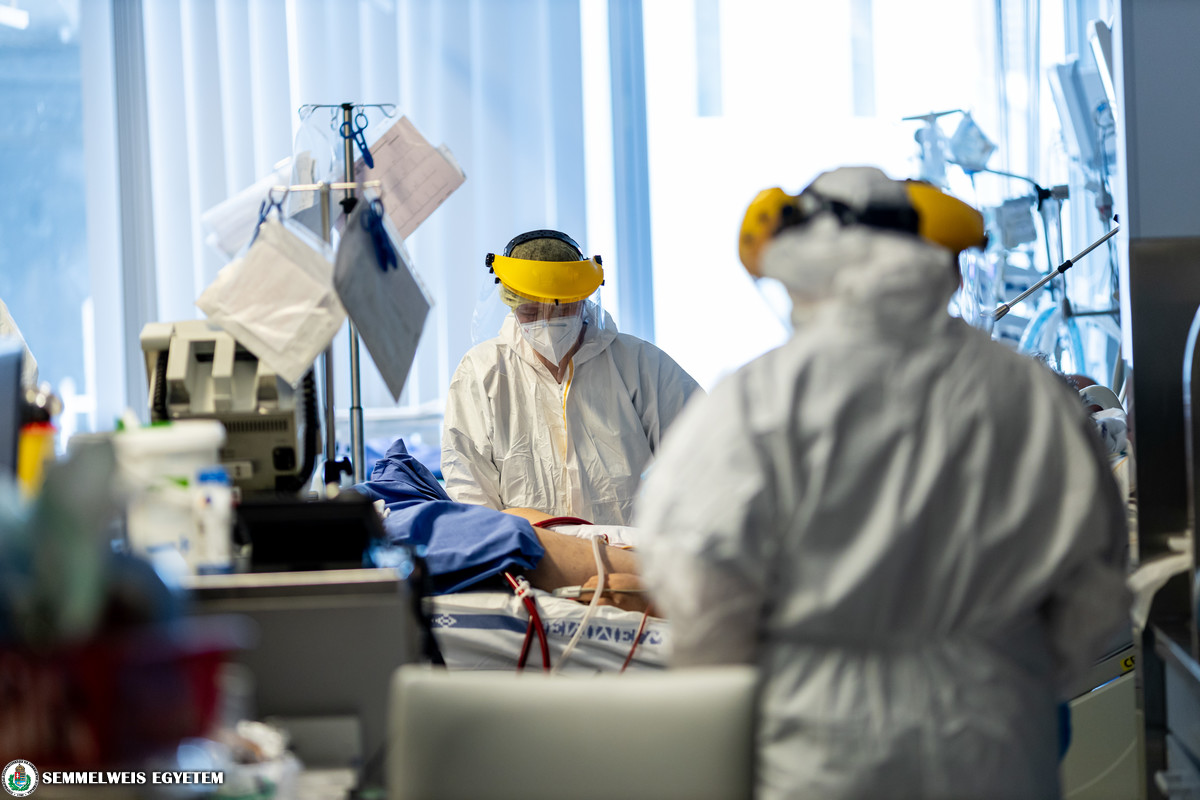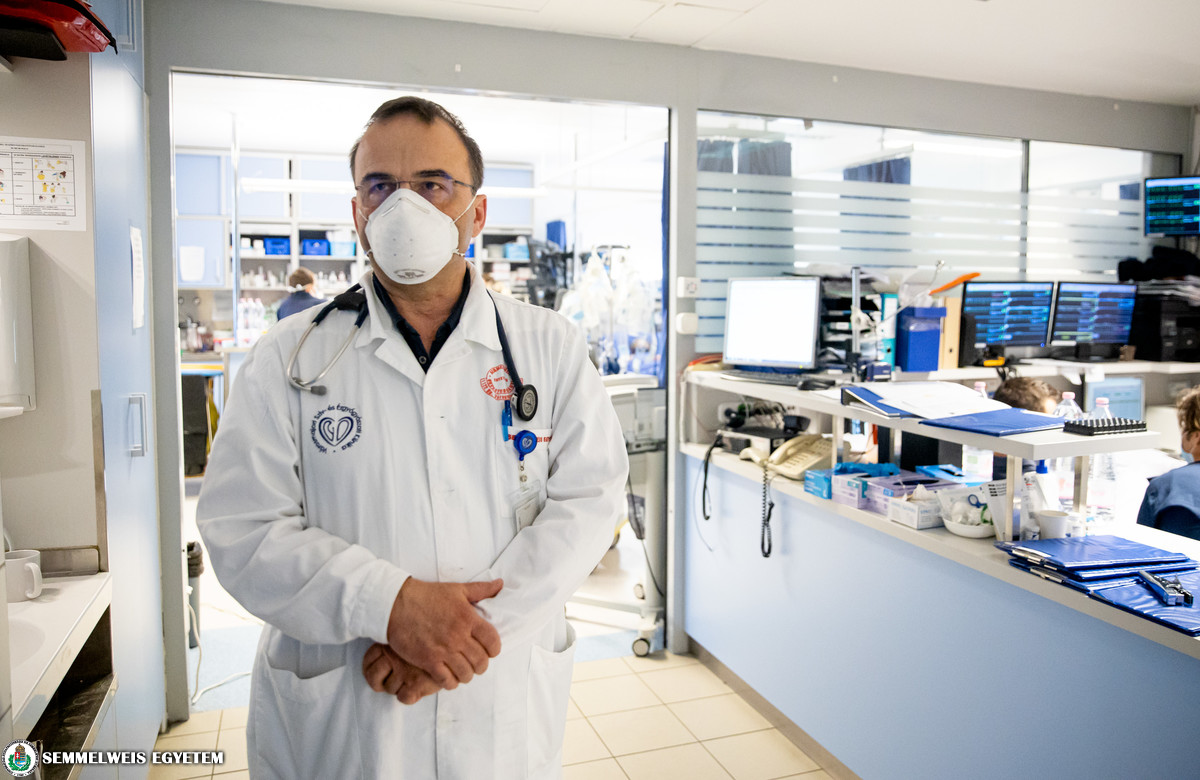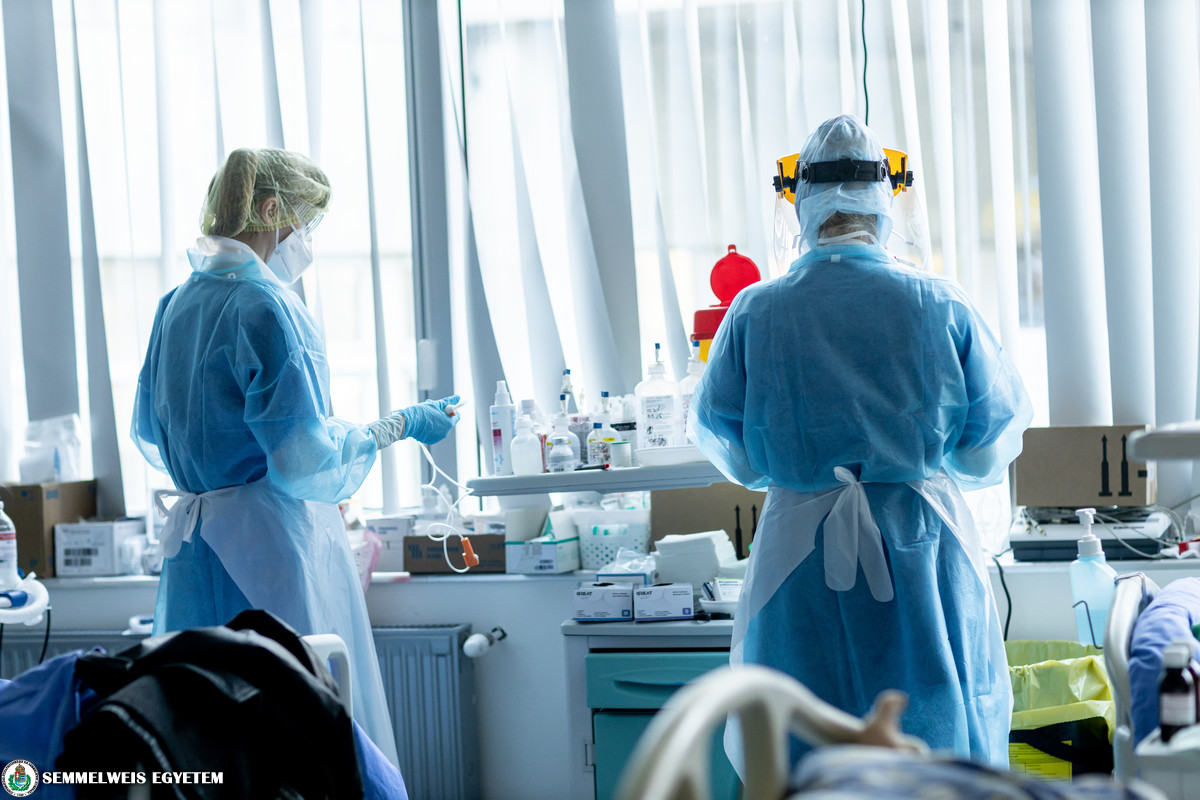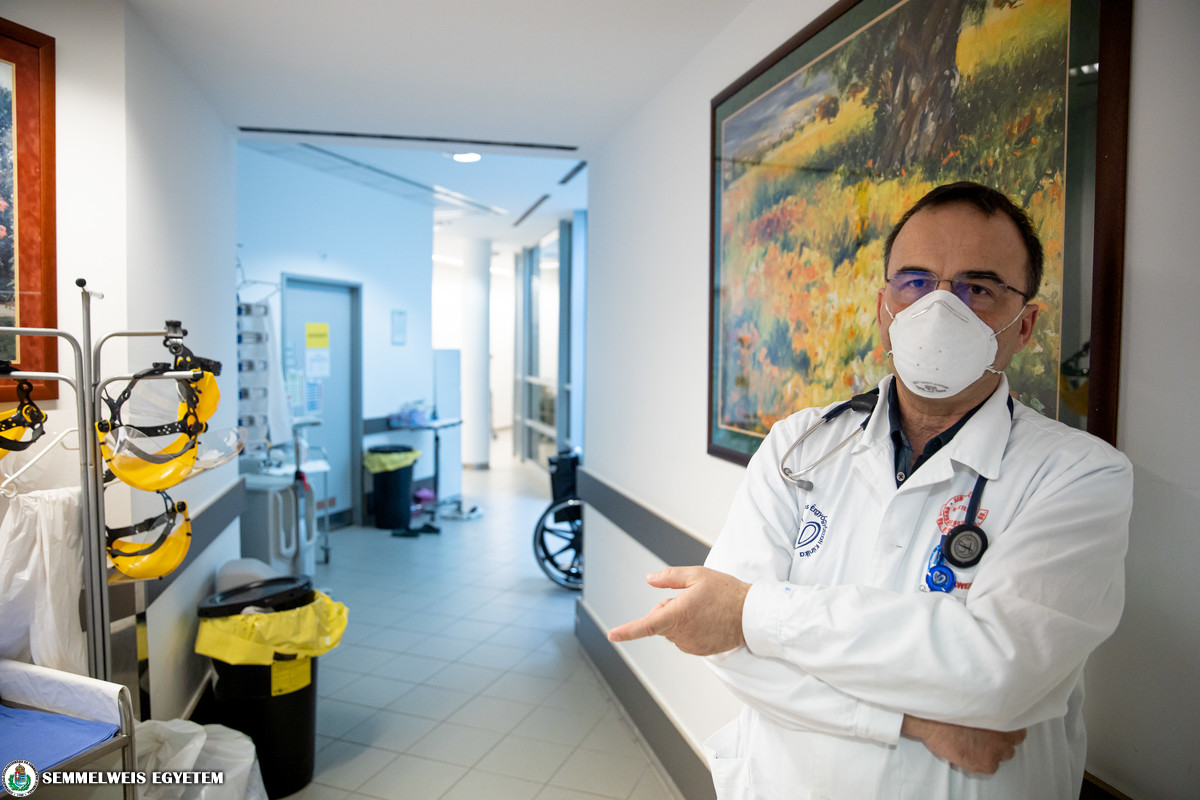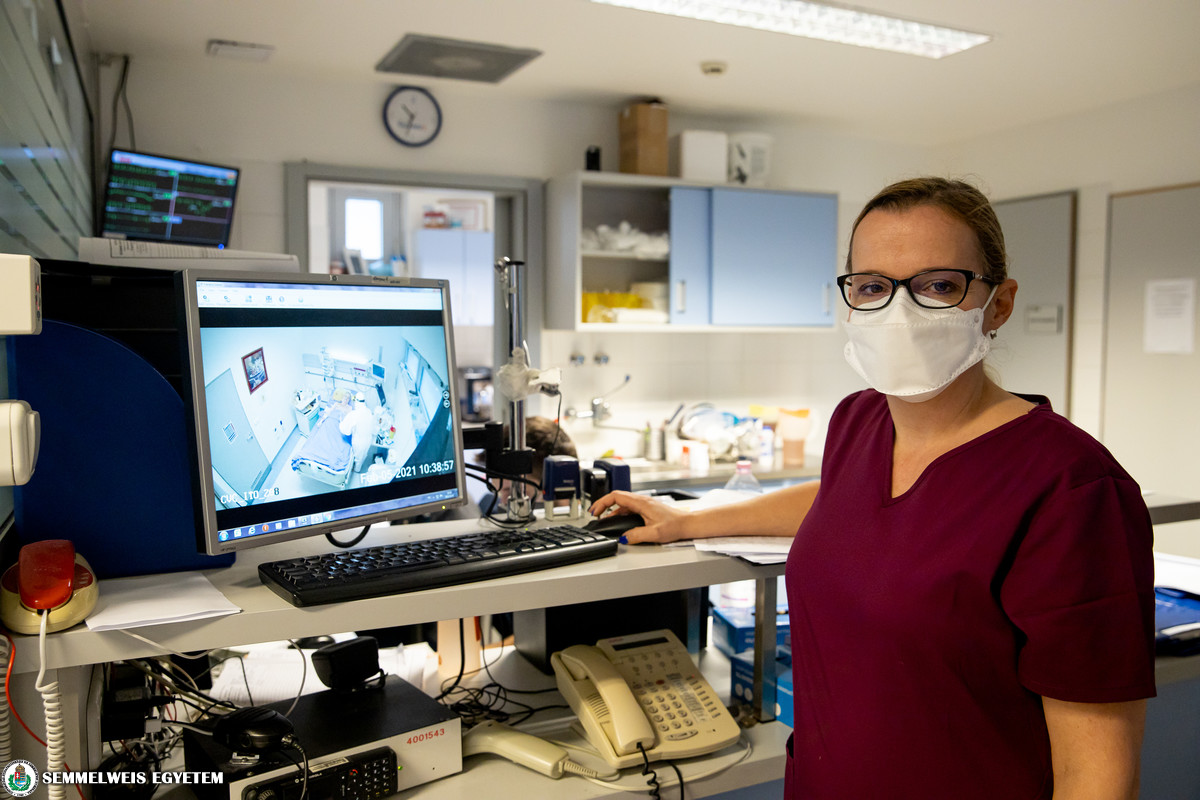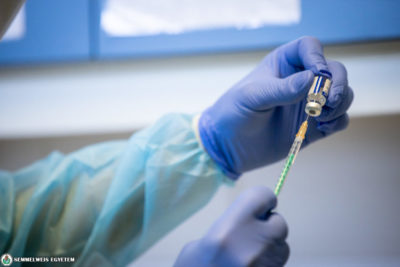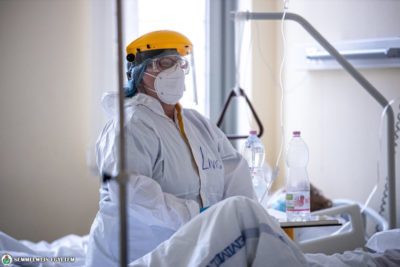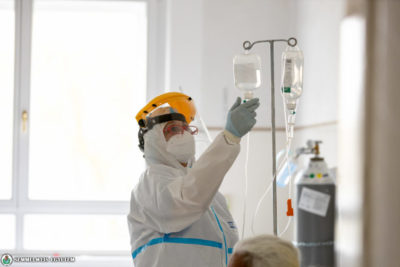The Heart and Vascular Centre has been involved in the profession-specific care of COVID patients since the onset of the epidemic in Hungary. One manifestation of the disease may be a thromboembolic event. Since last year’s spring, it has become more and more common for patients with such problems to find that COVID is in the background. We asked Dr. Dávid Becker, Deputy Director, and Judit Kádár Törökné, Head Nurse about their experiences as part of our series of articles presenting the units involved in COVID patient care.
“COVID is a very insidious virus that can take many forms”
Dr. Dávid Becker, Deputy Director, Heart and Vascular Centre
How long have you been involved in COVID patient care? Do you remember the first case?
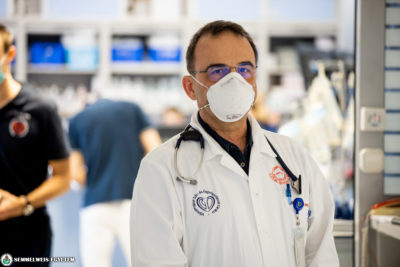 The first probable COVID case was brought to our clinic before the outbreak of the epidemic: a female patient in her 50s, who had been ventilated for three weeks, was transferred to our clinic from another institution. The patient had extensive bilateral pneumonia and she was suspected to have a myocardial infarction, since the cardiac death marker indicated an elevation. Back then, at the end of February last year, we could only find information based on the available literature, but it was an absolutely typical case. As it turned out, she also had a Chinese contact. The female patient was treated in isolation, we were provided with the appropriate protective equipment and we applied the hygiene standards, despite the fact that her PCR test had already proved negative at this time. Unfortunately, the patient later passed away because of an uncontrollable respiratory failure – she may have been one of the first domestic coronavirus patients. Since the domestic appearance of the virus, since last year’s March, we have been treating COVID-suspected and confirmed coronavirus patients. One manifestation of the infection may be a thromboembolic event, even a myocardial infarction. Since the start of spring, it has become more and more common for patients with such problems to find that COVID is in the background. With the increase of infections in Hungary, more and more patients appeared who needed acute cardiac surgery or cardiology care after being infected with coronavirus.
The first probable COVID case was brought to our clinic before the outbreak of the epidemic: a female patient in her 50s, who had been ventilated for three weeks, was transferred to our clinic from another institution. The patient had extensive bilateral pneumonia and she was suspected to have a myocardial infarction, since the cardiac death marker indicated an elevation. Back then, at the end of February last year, we could only find information based on the available literature, but it was an absolutely typical case. As it turned out, she also had a Chinese contact. The female patient was treated in isolation, we were provided with the appropriate protective equipment and we applied the hygiene standards, despite the fact that her PCR test had already proved negative at this time. Unfortunately, the patient later passed away because of an uncontrollable respiratory failure – she may have been one of the first domestic coronavirus patients. Since the domestic appearance of the virus, since last year’s March, we have been treating COVID-suspected and confirmed coronavirus patients. One manifestation of the infection may be a thromboembolic event, even a myocardial infarction. Since the start of spring, it has become more and more common for patients with such problems to find that COVID is in the background. With the increase of infections in Hungary, more and more patients appeared who needed acute cardiac surgery or cardiology care after being infected with coronavirus.
What is the role of your unit in COVID-19 patient care?
We provide profession-specific COVID care, which means that patients who are suspected of having an infection are brought to our clinic, or confirmed COVID-positive patients who are in need of a cardiac surgery and cardiology care. Already in the early period of the epidemic, several coronavirus patients were transported to our clinic, for example from the South-Pest Hospital Centre (Szent László Hospital), because of aortic dissection, which was successfully operated and treated by our colleagues of cardiac surgery and anesthesiology. There is also an increasing number of patients with acute myocardial infarction who also suffer from coronavirus infection. In these cases, it is possible that the plaque rupture that results in a myocardial infarction is caused by the viral infection. In addition to treating the cardiovascular disease, we also need to treat the coronavirus infection itself as well as its complications, and the patients treated here are typically patients with severe comorbidities or elderly patients who are particularly at risk for COVID-19.
To what extent did you have to reorganize work?
Just like nowhere else in the world, our clinic was not built in such a way, either, that there are completely separated red, gray or even green zones for a large number of patients, which is why transformation and a high degree of adaptation were needed. We have set up isolation wards, provided our colleagues with the facilities they need to dress up, and provided adequate protective equipment and hygienic conditions. Due to the dramatic increase in the number of cases in recent weeks, including the increase in the number of patients who cannot be kept under mechanical ventilation, the largest possible number of ECMO treatments are currently in progress at the Heart and Vascular Centre, using the maximum capacities and completely transforming the structure of the clinic. Patients include expectant mothers, or even young, otherwise especially athletic people – unfortunately, the virus really does not pick. This enormous effort is provided primarily by the staff of the Department of Anesthesiology and Intensive Care who work in the clinical division of the Heart and Vascular Centre, with the full support of the other staff of the clinic, of course. In order to provide the emergency care of the entire profile of the Heart and Vascular Centre, we are working in the form of a matrix supply optimized for the possibilities, for example colleagues in anesthesiology and cardiology have been involved in the anesthesiology care of cardiovascular patients, and of course our nurses and all of our staff will help where they can.
What differences do you see between the different waves of the epidemic at the department?
Foreign data show that fewer patients with myocardial infarction were admitted to hospitals during the first wave. We also examined the phenomenon, and the same was the case in Hungary. Despite the fact that the epidemic in Hungary was less severe in the spring than in Italy or Spain, the number of patients with myocardial infarction decreased by 20-30%. Presumably, the older people were afraid of the infection, so they did not seek for help or see a doctor. In the summer, in a more peaceful period, the difference as opposed to the data of previous years disappeared. However, during the second wave, fewer such patients were hospitalized again. This is also dangerous because an untreated heart attack can have extremely serious outcomes. That is why the clinic’s care strategy is to automatically accept all patients with cardiovascular complaints so that ambulances, GPs or other hospital staff do not have to consider whether the patient needs care: they should send the patients here and we will take care of all the examinations. Fortunately, a reliable antigen test can now be performed on site in order to possibly isolate a patient. We maintain this strategy in the current, dramatic third wave.
What are the most important lessons and experiences that will be useful in the future?
COVID is a very insidious virus that can take many forms. We have recently learned that we need to constantly monitor not only the typical but also the non-specific signs. In the case of bilateral pneumonia we now automatically think of coronavirus, but we also have to suspect other symptoms, be it diarrhea or deep vein thrombosis. Fortunately, the treatment of the coronavirus disease is also evolving: antiviral therapy, the use of monoclonal antibody therapy help patients to recover. The epidemic has taught us several things, one of the biggest lessons being the increased adherence to hygiene standards. We may have smiled in the past when we saw tourists from the Far East wearing masks, but today we have learned the importance of such precautionary habits. Consider that the flu epidemic is gone, and I am convinced that this is due to the forced wearing of masks.
I am very confident that we will be able to defeat the coronavirus, but we must continue to adhere to the increased hygiene standards, as these will benefit us all. And what was very good to see in these difficult times: the collaboration of colleagues, nurses, assistants, physicians with the director of the clinic at the forefront. Today, fortunately, everyone is vaccinated or protected from their previous infection, therefore we can do our job safely, even more focused on patients.
“Appropriate hygiene measures protect not only patients but also health care workers”
Judit Kádár Törökné, Head Nurse, Cardiac Intensive Care Unit, Department of Invasive Cardiology
In terms of professional and nursing responsibilities, what is the biggest change that the COVID situation has brought?
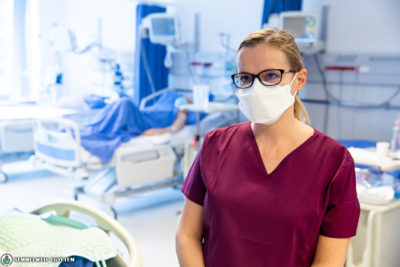 We also perform transplantations at the clinic, therefore we certainly have paid maximum attention to the hygiene standards so far, and proper dressing has been part of our job. However, the coronavirus has drawn even more attention to the importance of this and perhaps to the need to pay similar attention to protecting ourselves. Because COVID patients are treated in an isolated ward, in a segregated red zone, it is not possible to just run into their ward or run out of the ward if we have forgotten something. We need to think about the entire nursing process and all the tasks, and this makes the work of the staff significantly more difficult.
We also perform transplantations at the clinic, therefore we certainly have paid maximum attention to the hygiene standards so far, and proper dressing has been part of our job. However, the coronavirus has drawn even more attention to the importance of this and perhaps to the need to pay similar attention to protecting ourselves. Because COVID patients are treated in an isolated ward, in a segregated red zone, it is not possible to just run into their ward or run out of the ward if we have forgotten something. We need to think about the entire nursing process and all the tasks, and this makes the work of the staff significantly more difficult.
To what extent do these patients require a special nursing care?
The coronavirus greatly affects our cardiovascular system, and we treat patients with these diseases at the clinic. The biggest difficulty is protective clothing: it is not easy to find a vein or an artery via three rubber gloves, under such conditions any intervention becomes difficult.
How does the protective equipment change processes and the way you connect with patients?
Nursing staff also wear FFP masks, goggles and overalls over their own attire: not only is it hard to breathe in such equipment, but it feels like trying to care for patients in diving suits. Since last spring, we have become accustomed to speaking louder, and slower than usual, more articulated so that patients can understand us. Our work is greatly aided by the fact that cameras are installed in the ward, as this allows us to see what is happening to patients from the outside, and it is also easier to notice when a nurse inside the ward needs help. We also make good use of the walkie-talkies that we received from Semmelweis Kft., which facilitate communication between each other.
What are the most important lessons and experiences that will be useful in the future?
Adherence to asepsis-antisepsis, which is an extremely important part of health care, has come to the forefront again. The pandemic also drew attention to constant and ongoing hand disinfection as well as mask use. Appropriate hygiene measures protect not only patients but also healthcare workers. We all place great emphasis on how, and in what protective equipment we do our work, and this is expected to continue in the future. The third wave of the pandemic is a huge burden for the medical staff and physicians, and due to the increase in the number of cases, departments had to be reorganized and professionals redirected. It is still a priority to screen patients who come to us and to isolate the positive cases. It is important, however, that those who work here can do their job in a safe way, as we have all been vaccinated.
Ádám Szabó
Photo: Attila Kovács – Semmelweis University
Translation: Katalin Illés-Romhányi
